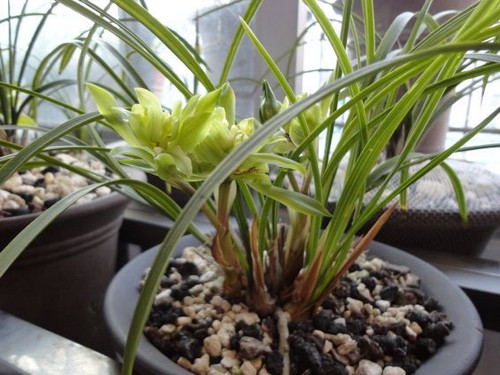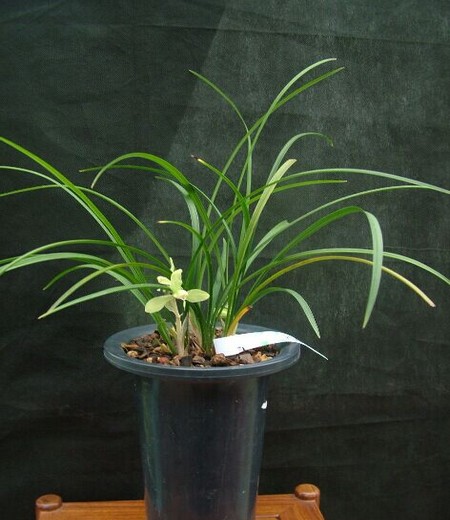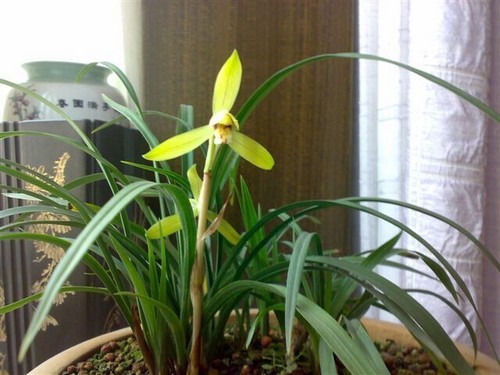Culture methods of spring orchids
Spring orchid is a very valuable orchid variety, which can be given to friends as gifts, such as "beautiful", "noble", "simple", "virtuous", "handsome" and so on. Spring orchid is a relatively famous flower variety, which can be decorated and beautified at home, and can be used as medicine and as a gift to friends. Chunlan flower is an elegant and cultural flower, and it is a very good flower variety. Orchid beautiful leaves, strange flowers, charming flowers, is a very precious pot ornamental flowers and plants, furnished in the living room and other places, will appear elegant and tasteful.

Through the long-term practice of cultivating orchid, the Chinese ancients summed up an experience of "four precepts" for nourishing orchid. That is, "spring does not come out, summer is rich, autumn is not dry, and winter is not wet." The so-called spring does not come out: orchids like to be moist, windy and dry in spring, and the temperature is relatively low. in order to avoid being damaged by cold wind, orchids can not come out of the room in spring and can be maintained in indoor half-light. But Cymbidium and Cymbidium should be placed in a sunny place near the windowsill. The so-called summer: orchids like shade, cool, avoid direct sunlight, especially afraid of hot sun exposure. Therefore, it is necessary to cultivate in a cool and well-ventilated semi-shade place in summer. The shade tolerance of orchids is the highest, followed by Jian Lan, while Cymbidium and Cymbidium need more sunlight. The so-called autumn is not dry: orchids, especially Jianlan, autumn is the bud period, most like the wet and cool environment, if the pot soil or air is dry, it is not conducive to its growth and development, leaves are easy to wither and yellow, but also fall buds, and affect the flowering of the following year. Therefore, the amount of water watered in autumn should be increased appropriately, and often sprayed on the leaves. The Autumn Equinox also needs to apply more mature dilute liquid fertilizer before and after. Some plant ash water can be applied to the roots during flowering, which is very fertile to promote the development of orchid roots, stems and flowers. The so-called winter is not wet: orchids are dormant in winter and need to be watered moderately. It is generally appropriate to keep the basin soil dry and wet. If the amount of watering is large, the root is easy to rot. However, the ink orchid blossoms in winter and should be watered more.
1. Pot selection: planting Cymbidium should be carried out at the end of autumn. Before planting, it is appropriate to choose a new tile basin that has been soaked in water for several hours, such as purple sand basin or plastic basin. The size of the basin is suitable for the root to stretch in the basin.
2. Using soil: orchid mud is the most ideal culture soil, or half-mixed with humus soil and sandy loam soil. Do not use alkaline soil.
3. Upper basin: first pad the tile on the drainage hole at the bottom of the basin (preferably with 3 drainage holes), and then put on the crushed stone, slag and other things, accounting for about 1 stroke of the basin, which is covered with a layer of coarse sand, and then put on the culture. It is best to put the orchid seedling into the basin, straighten the root, let it stretch naturally, gently lift the orchid seedling in the middle of the filling, and shake the flowerpot at the same time, so that the orchid root is closely combined with the pot soil, continue to fill to the edge of the basin, and press it. Leave about 3cm along the mouth for fertilization and watering.
4. Temperature: the suitable temperature for the growth of Cymbidium is 15 ℃ to 25 ℃, 18 ℃ to 25 ℃ from March to October and 10 ℃ to 18 ℃ from October to March of the following year. Even a short time of 0 ℃ in winter can bloom normally and can withstand a low temperature of-5 ℃ to-8 ℃, but it is best to keep the room temperature at 3 ℃ to 8 ℃, or keep the basin soil free of ice and leave it in a sunny place near the south window.
5. Shading: pour water into the basin and put it in a shaded place. Keep it indoors in early spring and winter, and put it under the shade for the rest of the time. It is shaded from 8 a.m. to 6 p.m. In summer, and the shading degree of Chunlan should reach about 90% in summer. It is about 70% in spring and 80% in autumn.
6. Watering: the leaves of orchids have thicker cuticle and sunken stomata, which are more resistant to drought, so they do not need much water, so it is better to keep the orchid soil "seven points dry and three points wet". In general, the basin soil should be watered once in 2-3 days in spring, slightly dry after flowering, slightly moist after April, once a day with high temperature in summer, dry and wet in autumn, and less in winter. Spring orchid bud period, it is appropriate to keep moist, but not too wet. In the dry and hot season, spray the ground around the flowerpot in the evening to increase air humidity.
7. Fertilization: spring orchids are especially forbidden to use raw fertilizer, thick fertilizer and large fertilizer, especially high concentration chemical fertilizer, which is very easy to cause dehydration and necrosis of fleshy roots. we should try our best to use thin organic fertilizer or special fertilizer for orchids to apply thin fertilizer frequently. Orchids do not apply thick fertilizer. It is not suitable to apply fertilizer in the first year of newly planted orchids, and it can not be fertilized until the new roots grow vigorously after 1-2 years of cultivation. Generally from April to the Beginning of Autumn, apply fully mature thin pancake fertilizer and water every 15-20 days; stop fertilizing in the heat of summer. It is appropriate to apply fertilizer in the evening and avoid liquid fertilizer fouling the leaves.
8. Bud thinning: one of the more important steps in spring orchid culture is to sparse buds, choose a bud with the best development and ornamental value, remove the rest and spray Zhuangtiling on the flowers. it can promote strong buds, enlarged petals, colorful flowers, rich fragrance and prolonged flowering period. When the spring orchid blossoms quickly, cut the flowers together with the flowers, do not wait for the flowers to fall off naturally before cutting, in order to reduce nutrient consumption, conducive to next year's flowering. After budding, it is appropriate to keep one bud with the best development and the best ornamental value, and the rest of the bud should be removed in order to make the flower beautiful. Spring orchids blossom for about 10-14 days can be cut off together with the flowers, do not wait until the flowers fall off naturally before cutting, in order to reduce nutrient consumption, conducive to next year's flowering.
9. Pruning: keep pruning in orchid culture. When the old leaves are withered and yellow, they should be cut off in time to facilitate ventilation, and the withered tips of some leaves should also be cut off. In particular, the leaves damaged by diseases and insect pests need to be removed in time to avoid infection. When cutting off leaves with virus disease, do not use scissors to cut disease-free leaves to prevent the virus from spreading. If the same pair of scissors is used, it needs to be disinfected.
After the flower buds of precious orchids are unearthed, if there are too many flower buds, strong buds should be left, and the rest of the thin flower buds should be removed, leaving 1-2 flower buds in each pot. If there are too many flower buds, it will not only make the flowers bloom badly, but also consume too much nutrients of the maternal parent to affect the flowering next year. In general, orchids do not cut off flower buds.
The flowers of Chunlan, which bloom for about half a month, need to be cut off, and the flowers of Chardonnay should also be cut off when the last flower on the inflorescence blossoms for a week. Valuable varieties should not be pollinated, otherwise they will blossom the following year. If it is used as a cross breeding, it needs additional culture to make its fruit full and ripe.
10. Insect pests: spring orchids are more prone to insect pests, such as white silk disease, anthracnose, scale insects, root rot and so on. Pay attention to ventilation and light transmission, basin soil drainage is good to prevent, the onset period can be treated with 50% methyl thiophanate wettable powder 800-1500 times liquid spray, 7-10 days each other, and then supplemented with 1% equivalent Bordeaux solution, once every semimonthly. If the harm is serious, the pot should be changed immediately and replanted.
Time: 2019-06-01 Click:
- Prev

How to raise spring orchids
As a lofty object in people's aesthetic appreciation, orchids become a concept after consideration and consideration. When this concept is applied to language, it becomes a word. In the long history, out of closeness and respect for Lan, people have created many beautiful words to express the beautiful things around them.
- Next

How to raise spring orchids in the family
Chunlan is a typical representative of the petal flower of the national orchid, which has been widely spread since ancient times. Chunlan has a wide range of famous products with stable and moderate prices, which can be accepted by ordinary enthusiasts. But it is cheap to buy and expensive to raise. Take a look at how to raise Chunlan in the family! The environmental requirements of Chunlan: Cymbidium prefers a cool, half-yin and half-yang environment, and does not need much fertilizer.
Related
- Fuxing push coffee new agricultural production and marketing class: lack of small-scale processing plants
- Jujube rice field leisure farm deep ploughing Yilan for five years to create a space for organic food and play
- Nongyu Farm-A trial of organic papaya for brave women with advanced technology
- Four points for attention in the prevention and control of diseases and insect pests of edible fungi
- How to add nutrient solution to Edible Fungi
- Is there any good way to control edible fungus mites?
- Open Inoculation Technology of Edible Fungi
- Is there any clever way to use fertilizer for edible fungus in winter?
- What agents are used to kill the pathogens of edible fungi in the mushroom shed?
- Rapid drying of Edible Fungi

